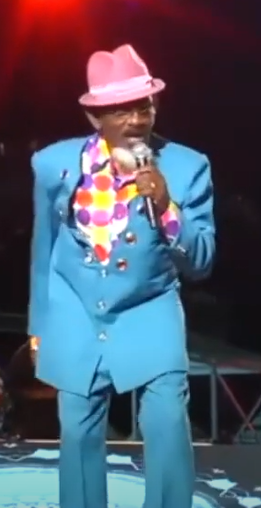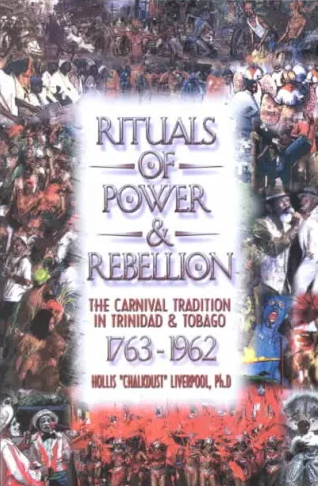
Contacto
Richès Karayib introduces you to the brilliant Hollis Liverpool, better known as Chalkdust. He is a Trinidadian calypsonian who holds a Ph.D. in history and ethnomusicology from the University of Michigan.
He has been singing Calypso since 1967 and has recorded more than 300 titles.
He is a nine-time winner of Trinidad’s Calypso Monarch competition, most recently in 2017.
He is also the author of books that are talking about Carnival and Calypso history .
Dr. Hollis Liverpool is telling us more about the history of the Trinidad & Tobago’s Carnival.
How did the festival of Carnival come to Trinidad and Tobago?
Was it started by Trinidadians?
Did it come from Europe?
What are the meanings behind the several masks and provocative dances in Trinidad’s carnival?
These are soul-searching questions that anyone interested in the festival would necessarily want to know.
It is a known fact that Carnival as a festival was indeed a feature in many French cities from the 16th century onwards, and since Frenchmen took over the tilling of Trinidad’s soils in the late 18th century, it is believed in many circles that the origin of Trinidad’s Carnival can be traced back to France.
My research has shown, however, that with the advent of the Europeans (mainly English, French, Spaniards and the Dutch) and Africans, traditions of festivity brought to Trinidad by migrants were practiced and developed for different reasons, into what became the Trinidad Carnival.
Just as Europeans brought their traditions to Trinidad, so too did the Africans during the era of the Atlantic slave trade, and these African traits survived to colour the festival and make it into what it is today.
It is fair to say, however, that the carnival developed in Trinidad and Tobago over the centuries is, to a large extent, African in form and function.
The africans
Met in the yards and held dances
Mocked their owners
Performed ancestral rituals
THE BARRACK YARD
The Period of White Domination
During the Pre-Emancipation era, the Europeans held their carnivals in ballrooms, went house to house visiting and passed laws whereby Mulattoes and Africans could not enter their hallowed, festive halls.
Indeed, the Europeans feasted lavishly amidst the near starvation that the Africans experienced.
A young German noted in 1831: “the dances are usually African dances and the enthusiasm of the negroes and negresses amuses us very much.”
Whites were at the top; they were laughing at the misfortunes of those whom they oppressed in a way to affirm their domination.
Resistance and Rebellion
The Africans, however, especially before 1838 when they were legally freed, used not only the carnival, but their worksongs, their calypsos, their wakes, and other religious and social settings as forms of resistance.
Carnival for them meant thanking God for their harvests, for being able to survive in that era of violence, and to demonstrate, above all, that they were not animals as the Whites believed, but a dignified people.
Such resistance continued throughout the 19th century and the nature of their masquerades, namely: devils, pierrot grenades, jab jabs and negres jardins underscore their aim to laugh at Whites, resist the elites and promote their own self esteem.
Collective resistance could be seen too in Trinidad in 1805 when there was a confrontation between Whites and Africans.
To a large extent, the structure and management of the warring bands of Africans complemented the structure and management of the carnival bands of the era.
As early as 1834 too, Africans were prevented from wearing masks.
Mrs. Carmichael wrote of the resistance nature of their songs and of the fact that they would set fires deliberately to the canes and then re-enact the Canees Brulees procession to laugh derisively at the losses of their masters.
An aged stickfighter informed me that he learnt from his grandmother that the kalenda dance and stickfight was one of defiance intended to challenge the ruling of whites who had sought to ban it in 1810.
For Professor Gordon Rohlehr :
Mrs. Carmichael’s work shows that Africans not only resisted through song and dance, and had an offstage life of satire, but that many African melodies survived the Atlantic crossing to become part of the armoury of New World Africans.
In 1834 too, the Africans, by way of the masquerade, brought out an Artillery band mocking the English Militia.
The English Commandant agreed that the Africans were making a “mockery of the best Militia band that has ever been embodied in the West.”
The Period of Growth and Self-Esteem
For the freedmen after Emancipation, carnival had a different meaning.
With the White plantocracy having economic problems, and with the English trying to anglicize the island’s institutions and thereby offending the French and Spaniards, the way was cleared for the Africans to take over carnival.
For them it fulfilled their spirit of self–esteem and their manner of showing the Whites that they were indeed free, if not in terms of education and economics, at least in spirit and in their ability to win for themselves the lands, the old estates and the streets.
Hence, they paraded allover the streets; no zone or area was out of bounds for them.
In addition, the research of Professor Errol Hill and my own show that:
the Africans associated carnival with the celebration of freedom
by holding their festivities in the Post-Emancipation era for many years on August 1st, the date of their liberation.
There are many places in the Caribbean today, including the BVI, where carnival is still celebrated on “August Monday” as they call August 1st. In Barbados, it is associated with “Crop Over” recalling the harvesting of canes that engulfed the festival, and “Mr. Harding,” representative of the elite planters, is still ceremoniously burnt.
The continuation of Jour Ouvert in the 20th century and up to this day is further proof of the determination of Africans in Trinidad to continue with their African traditions and African-inspired masks, despite the laws and regulations of the 19th and 20th centuries passed by governments to stamp out the practices and, in their opinion, sanitize the festivity.
At the turn of the 19th century, Whites interjected the carnival with European values and so-called “respectability.”
From 1873 to 1962, there was a constant struggle between the Whites and Africans, Whites and Creoles, Creoles and Africans, the upper class and the lower class, the upper class and the middle class, Catholics and Anglicans, Jamettes and Police, colonials and masqueraders, legislators and calypsonians, pressure groups and steelbandsmen, for control of the right to freedom of artistic expression. Laws passed especially in 1868 and 1884 sought to drown out every African trait that was related to the carnival.
And still it survived; the stickfighters ensured, by their exuberance and by their violent opposition to the colonials in 1881 and 1884, that it did.
The Period of Mimicry: Themes of War and History
Yet another meaning of Trinidad’s carnival was seen in the mid-twentieth century unto the 1970s when the masqueraders, anxious like the populace to learn of the history and culture of other lands; when the value of education was paramount, and when to be educated was to be versed in History especially :
Although for some bandleaders it was tantamount to mimicry, it was for many a learning experience. Thus, bandleaders like Harold Saldenah, George Bailey, Bobby Ammon, Edmund Hart, Stephen Lee Heung and Irvin McWilliams, to name a few, brought to the streets of Trinidad the princely warlords of “Imperial Rome;” “Norse Gods and Vikings;” “Relics of Egypt;” “Byzantine Glory;” “China, The Forbidden City;” and the citizens and architecture of “Bright Africa” as well as the “Amerindians” of North and South America.
The carnival during that era was for most people who, having won for themselves independence, found in carnival, a basis for demonstrating nationalism and freedom from colonialism.
As such, they were anxious to examine the cultures of other nations, especially those who had also suffered a similar fate.
Art Movement: The Era of Peter Minshall
The late 1970s and 1980s has been so overwhelmed by Peter Minshall’s art that it is difficult not to call the period, the era of Minshall.
Here, carnival took on another meaning.
His entry into mas has been described as “the biggest popular event since the historic Canboulay riots of Trinidad Carnival 150 years ago when revelers defied the authorities to masquerade the way they chose.”
He was concerned with society at world level and was more engaged “with the world picture” than with “the microscopic picture of Trinidad.”
Hence, he saw carnival as art movement and as theatre. He commented: “I put colours, shape and form on these people and they pass in front of the viewer like a visual symphony.” Minshall’s Paradise Lost (1976), Danse Macabre (1980), Papillon (1982), The River (1983), Callaloo (1984), and The Golden Calabash, to name a few of his presentations, gave carnival a new meaning. They represented “much more than feathers and sequins.
They are sculptures, poles and cloth articulated by the limbs of the body, which acquire life, because they are based on, and follow, the movements of the performers in a combination of dance and music, producing ever-changing shapes in Dionyesian explosions.”
Minshall who at a conference in Connecticut told the audience that, to a certain extent, all his “masquerades are based on the concept of the bat,” caused people then to view carnival differently.
He brought a new meaning to art. It was to mean the reflection of the soul of the people. It was to nourish that soul and to cause the nurtured soul “to break forth in grace and beauty and truth” on carnival day.
He himself stated: “While I agree that books are important, theatre, song and dance as mas is worthwhile and quite valid. It needs no apology.”
The Roaring 90s: Carnival as Industry, Business and Entertainment
Finally, ever since carnival was played in Trinidad and Tobago, there were those who played to steal from whites, to display their sexual prowess, to mimic the covered but nevertheless dirty linens of the upper class, and above all, to simply have a good time.
Famed historian and author who studied carnival, deceased Andrew Carr, informed me way back in 1966, that while
There were those who after Emancipation simply wore masks to terrorize Whites; there were those who at the turn of the century played certain masquerades, such as “Police and Thief” and “Highway Robbers” to simply extort from the rich elite, money or any form of material wealth.
Similarly, with the global economy opening up more and more to bandleaders, and with the prospects of making more money from the art form, there are those bandleaders who, from the 1990s and thereabout, placed the emphasis on what I call “Fast- Food Mas.”
They emphasize sequins and beads and design the masquerade, not with art or history in mind, but in terms of women and the women’s love for showing off their sexual dimensions and sensual indulgences on carnival day.
As it is in Mas, so it is in the calypso, where many singers today stress the “wine and jam” themes, instead of the serious commentary that comprised calypso songs of the 18th, 19th and 20th centuries.
When I asked why he composed such trivialities today, instead of putting the emphasis on lyrics that make sense, famed calypso singer and song writer, Iwer George, retorted: “I have to eat a food.”
Conclusion
If it were a mere released safety valve, it would not have shown its continual rebelliousness year after year; there would have been greater forms of accommodation on the part of the oppressed groups having had their valves continuously released.
One must note that, unlike Bakhtin’s market place, where “undominated discourse (and) uninhibited speech prevailed,” in Trinidad the “uninhibited speech” was itself in part a product of the speech that was suppressed by the elite and the Colonial Government.
As such, the ridicule, aggression and mockery seen in Trinidad’s Carnival make sense only in the context of the effect of power relations that took place during the rest of the year.
Moreover, the explosiveness and vigour of the Carnival players and the extent to which the lower classes went to mock and ridicule were, to a large extent, the result of the inequalities in status and power between opposing classes.
In the case of Trinidad and Tobago then, through mas costumes, through music, song and dance, masqueraders brought and continue to bring together the legal and the illicit, the permitted and the forbidden, the ritual and the non-ritual, the vagaries of morality and immorality, the formal and the informal to create a social field of encounter, comedy, art, theater, entertainment, mediation, power and rebellion.
What is unique about the carnival in Trinidad is that in one day, multiple ethnic groups draw from the festival multiple meanings and consequently display multiple patterns of behaviour.
Some seek to enjoy themselves despite the cost involved; some seek the competitive edge; some seek to show off their power: economic, sexual, energetic, and otherwise; others seek to show and underscore the africanisms of their ancestors.
About
Hollis Liverpool
“Chalkdust”
9 TIMES WINNER OF CALYPSO MONARCH

1976
“No Smut For Me” & “Ah Put On Meh Guns Again”

1977
“My Way Of Protest” & “Shango Vision”

1981
“Ah Can’t Make” & “My Kind of Worry”

1989
“Chauffeur Wanted” & “Carnival Is The Answer”

1993
“Kaiso Sick in de Hospital” & “Misconceptions”

2004
“Fish Monger” & “Trinidad in the Cemetery”

2005
“I in Town Too Long” & “Ah Doh Rhyme”

2009
“Doh Touch My Heart”

2017
“Learn From Arithmetic”
AN AUTHOR

Rituals of Power and Rebellion: The Carnival Tradition in Trinidad and Tobago, 1763-1962

From the Horse’s Mouth
next RICHÈS KARAYIB
Appointment on the 02/02/2021
Sign up now to be informed!
PREVIOUSLY ON RICHÈS KARAYIB
TRENDING SXM – Blazing Marketing Trends
Richès Karayib introduces you to 2 dynamic businesswomen : Kimberly Meyers & Janelle Presentacion They own Trending SXM, a media marketing and production company located in Sint Maarten. Their goal Elevate the marketing of businesses and help them to achieve their...
ARTE ECO DECORACIONES & ECODECO DISEÑO SOSTENIBLE
ARTE ECO DECORACIONES & ECODECO DISEÑO SOSTENIBLE Richès Karayib presents the story of two women, two ecological carpenters, Andrea Cortes and Lizeth Ospina who have created 2 companies Arte Eco Decoraciones and EcoDeco Diseño Sostenible. The companies,...




0 Comments